As we all know we’re 70-80% water. That means that our bodies are constantly striving to replace the lost fluids by drinking water and eating juicy fruits and vegetables. Out body flushes out toxins through sweat, urine and other bodily liquids. It is important that we provide the body with enough of water in order to improve the detoxifying processes. If your urine is dark yellow to orange (and has a nasty smell) you’re obviously dehydrated and your body is struggling harder than usual to remove the toxins.
[the_ad_placement id=”in-text-1-type-a”]So, in order to avoid such situations you need to drink on average of 2.7-3.8 liters a day. For women it’s at the lower limit and for men the upper limit. A cup or two on top of that is also enough. Still, you probably know that our body uses water that comes from food as well. It is estimated that 20% of the liquids we consume daily come from food alone.
So, keep in mind that the more juicy and watery foods you eat (fresh fruits and veggies) the higher the water intake, which is exactly what you want. Here we’ll talk about all the different watery sources.
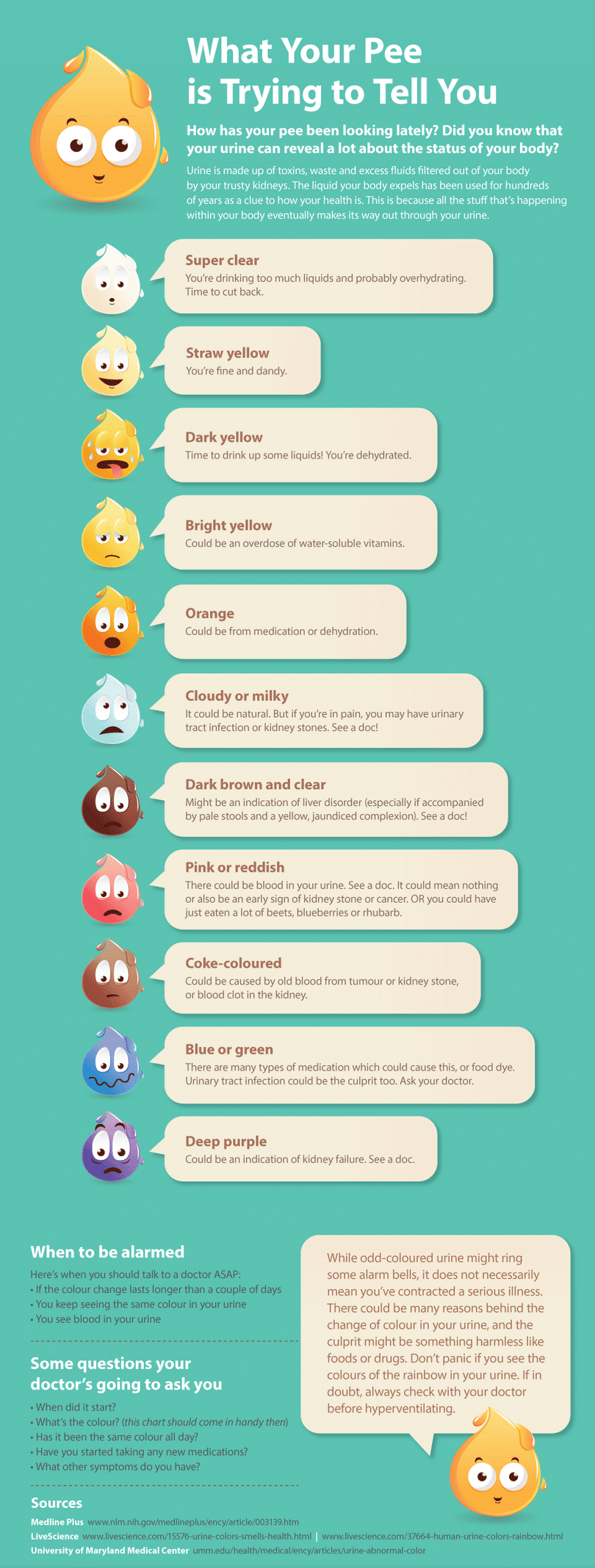
Smart ways to stay hydrated throughout the day
Hydration on a regular day can be pretty basic but it can apply even to hikers and tourists.
It’s no surprise that water is the best hydration drink that can be found. It is true that some sports drinks claim they hydrate faster and more efficiently, but most of them have calories. If you want to avoid a higher caloric intake, definitely water is the best option that exists. However, if you want to consider the sports drink, we reviewed some of the best hydration drinks on the market and you can read about it here.
If you’re going with water, you should drink one cup every hour to avoid dehydration. If you don’t know whether you’re dehydrated, there are some signs you can look for. If the color of your urine would be dark, that’s a certain sign of dehydration. The thirst in your mouth (dry mouth) is also a strong sign of advanced dehydration. It may be surprising to you, but being thirsty means you’re quite ahead in dehydration. You don’t have to wait for these signs in order to take measures. Stay ahead of the curve by drinking regularly, every hour.
Another easy and intuitive method is to just eat fruits at least 3-4 times a day. As we already mentioned they will provide 20% of your daily intake of fluids. If plain water is too much for you, fruits can be your savior. A note about children though – it is hard to keep children drink the required amount of water so you can either opt for fruits and veggies, or even give them sports drinks now and then. Since children are physically very active, a sports drink would make sense. They would also like the taste.
There are also low-calorie versions, so if you’re concerned about weight gain, you can go for those. Of course, there is coconut water which is even better. Coconut water is a natural source of electrolytes, without the suspicious additives some sports drinks contain. It’s always better to go for the natural sources when possible.

It may be trickier to stay hydrated on the track. There are many situations during hiking that can make it harder to avoid dehydration – lack of water sources, extreme heat, the location (you’re far away from civilization), etc. There are some very useful tips which we’ll share with you here.
Tips on how to stay hydrated when hiking
Before you actually go on your hike, you have to know your route. This is extremely important since it will help you plan ahead how much water you’d need. Is it a long trail, or just one-day hike? Are you going through steep terrain all the time, or it’s even? The more you’re straining yourself, the quicker you would dehydrate.
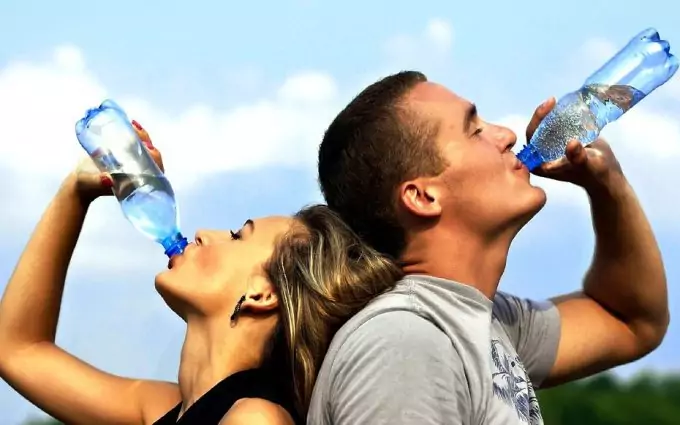
So we have to mention water again, but this time there are a few things you need to keep in mind. Before you go on your way, drink a half liter of water in the morning (before you leave). That would replenish your body stores of needed fluids and keep you hydrated for a few hours.
When it comes to water, always keep a spare bottle (container) of water in your backpack, as a back-up. Don’t drink it, unless it’s absolutely necessary and lifesaving. Otherwise, always try to find water sources. And don’t forget the water purifying or filtering systems. If you’re just hiking in low altitudes, water may be contaminated. You don’t want catching some potentially deadly disease. We have a great article with water filter reviews here so don’t hesitate to take a look.
Another very important tip is to drink in small sips. Don’t think that drinking huge amounts at a time would do you any good. It can make you sick in fact, which would lead to faster dehydration. By drinking in small sips you help your body to use the water more efficiently and avoid dehydration in the long term.
[the_ad_placement id=”in-text-2-type-a”]Don’t be afraid to always use the water sources you find on your way. If you know your area and know every water source, then you know how to plan your water usage. Otherwise, keep a filtering system and replenish your stores. Remember though, the higher you go in altitude, the lower the risk for diseases and bacteria in the water. Higher altitudes are not as hospitable to living organisms and there are fewer such that cause problems. It won’t hurt to filter your water of course, so if you’re in no rush, you better purify it – it’s a good habit.
Another good advice we can give you is to use a Camelbak hydration system, where you store the water as stays on your back all the time and you can drink through a hose. Stopping and removing your backpack to drink water, and then putting it on again, can be very exhausting at some point, and you need to conserve your energy and lose as little fluids as possible. The more you’re sweating, the quicker you will dehydrate. So, optimize your backpack with a camelback for efficient drinking.
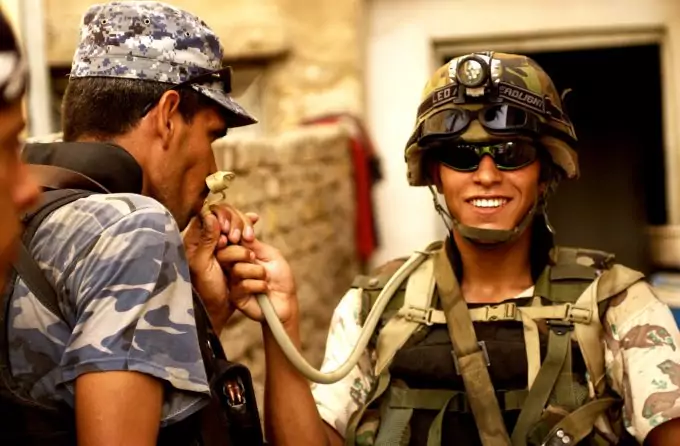
As we mention the Camelbak, these hydration packs that recently started gathering the attention of athletes and hard-core climbers and mountaineers, are a great way to evenly distribute water in your backpack. These hydration packs are compact and they stay close to your body. They are made of durable plastic that can be frozen before you go hiking. When you’re on your way, it will slowly melt and will keep the water cool, which is great during very hot weather.
It’s much more inconvenient to carry several bottles just to make sure you meet the recommendations. Having a Camelbak is the ideal way to do that. People get so used to it and see the benefits that they would never go back to the old ways. We highly advise you to try this way of keeping water close by and, if you want to browse through more products, take a look at our best hydration bladder article with reviews.
Of course, we still think it’s a great idea to keep a spare water bottle just in case. Always keep extra water, even if you never touch it. It’s best to have more, than to have nothing.
If you want to keep your water cooler during summer hiking better go for aluminum bottles. Plastic bottles can heat the water very quickly. After all when you’re hiking in hot conditions you want to stay cool, and warm (even hot) water will not help you with that.
A few more details from experienced people
Think also that you lose water even through your mouth. Your breath is always warm and moist, so if you’re already dehydrated (but are lacking in water sources) at least try not to talk and think of preserving your body fluids.
In case the weather ends up being too hot than you expected when you started on your hike, you have to know a few more things.
Severe dehydration has some more nasty and dangerous symptoms which you must be aware of. You may experience dizziness, pain in the muscles (cramps), increased heartbeat (pulse), nausea, etc., then you should know that your dehydration had hit serious levels and you need to take immediate action.
If there are no water sources nearby and you’ve ran out of your own water supplies then this either means you haven’t been well prepared, or you’re lost. For the latter situation it may help to know that a human can survive several days (3, max 4) without water. Otherwise, to avoid being unprepared you have to consciously put it in your list that you need to have at least 2 liters in your backpack, per day, per person. The optimum amount is 6 liters, if you can carry all that weight, including the other gear you had packed.
You also have to know that dehydration means that your body loses not only water, but also vital elements and electrolytes. So, these you have to replenish. You can do so by adding sodium and potassium to your water bottle. There are hydration tablets (usually for athletes and sold in sports shops) which can be added to the water container. They have many minerals vital to your health, and most importantly, they contain sodium and potassium which contribute to well balanced hydration.
As we pointed out earlier, if you experience cramps, this is because your body is losing salts and this impairs the proper function of your muscles. After all, salt contributes to the electrical impulses to be transmitted from your neurons to your brain. Without salt, the electrical impulses cannot occur and your bodily functions get impaired, hence the cramps.
Yet another tip from us – if you’re planning on hiking in very hot weather, better take more than you think you’d need. Sometimes in extremely hot conditions, when you constantly sweat a lot, you may need even a liter every hour. This is especially true while you’re moving, walking, climbing, etc. When you’re resting your water needs are significantly lower. We wouldn’t advise you to go in such hot conditions alone, especially in deserted areas where you know beforehand that there are no water sources.
You never know what may go wrong. Going together with a group of friends is much wiser. It is also a good idea to keep transport not far from where you’re hiking. If something happens and you need medical care you have to be able to drive back home to be taken care of.
You may want to consider bringing coconut water along. You may use it only in extreme situations when you’re really exhausted and have run out of water. Coconut water has those precious electrolytes that help your body hydrate quicker and more efficiently. Drinking only water will not replenish the lost amount of sodium and potassium, unless you explicitly take them (tablets or supplements).
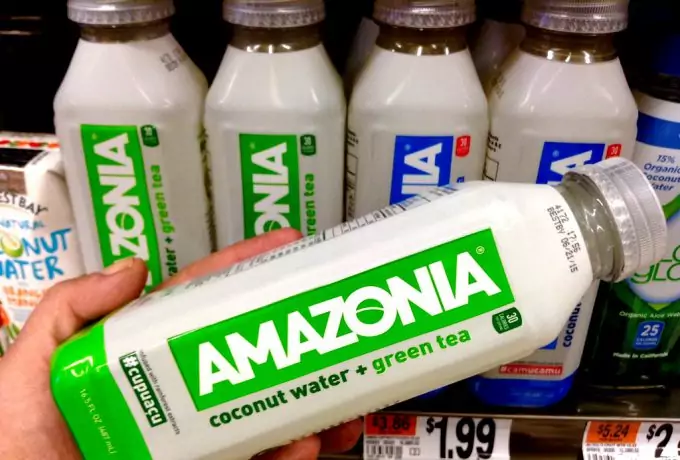
If you’re hiking through forests you may be lucky to come across forest fruits, like wild blueberries. If you’re 100% sure these are blueberries, you can safely eat them. Strawberries are easily recognizable so there’s no doubt if you see them. We advise you to make a research in advance on how to recognize copy-cats and to make sure you’re going to eat what you believe the fruit is. There may be some poisonous fruits which look like blueberries and other wild berries. As long as you know what you’re doing fruits can be your savior, if there’s lack of water supply. So, to make sure you don’t accidentally eat something poisonous, take a look at our article on edible wild plants.
Of course, if the conditions allow it and it’s moist, you can gather rainwater (it may not need any filtering). You can also build a system where to gather water. You can dig a hole and cover it with plastic. Place a bottle inside the hole so the bottle is completely inside the hole, but the opening is not covered. If the soil is moist enough (or it’s rainy), water will gather in the hole. Now place a mildly heavy rock on top of the plastic sheet so it is right above the bottle opening – the condensed water will drip inside the water bottle.
Place foliage and leaves inside the hole to increase the water content. You need to be patient with this method since it takes time. If it’s very hot the water will condense quickly. If there’s already lots of water in the hole, you may be sure to have a drink within a few hours. If you’re hiking in much plainer terrain with no trees, foliage, bushes or water sources, then this method can hardly be of use.
[the_ad_placement id=”in-text-3-type-a”]The harsher the conditions you expect, the better your preparation should be. And our tips above would be incomplete if we don’t talk about how to prevent severe dehydration, or at least how to slow it down.
One important thing is your clothing. Tight clothes are a worse idea if you want to optimize your hydration. Loose clothes are a much better option since the air between your skin surface and the clothing layer stays relatively the same, while the overall temperature of the air you breathe is much higher.
Thus, the skin exposed to the ventilated air under your clothes is slightly cooler. Tight clothes (if not appropriate for hiking) would actually prevent the perspiration process and this will in fact make you feel hotter and it would lead to stronger sweating. Sweat is the way for the body to cool down, so you need it to work properly. Clothes perfect for hot weather are always made of synthetic materials, like polyester and nylon.
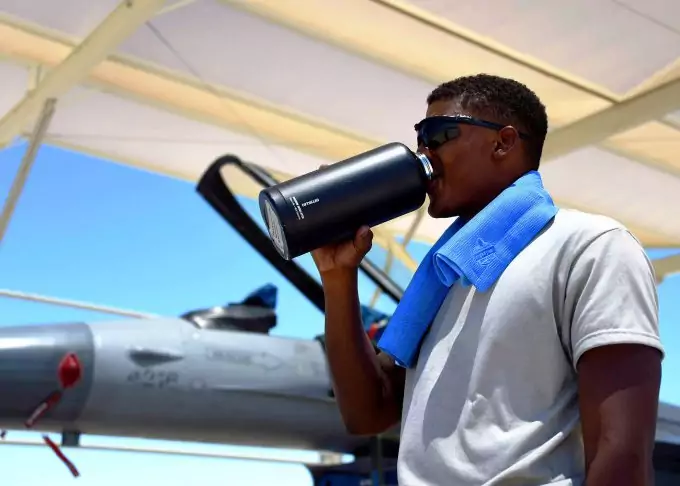
As we’ve been talking a lot about dehydration in hot weather, we have to talk a little also about cold conditions and winter hiking. As it’s cold you may not feel thirsty the same way you do when it’s hot. Thirst is also often a signal that the body needs to cool down, but proper hydration is as important during the winter as it is during the summer.
Dehydration leads also much quicker to hypothermia and frostbite than you may think. Remember also, that higher elevation puts strain to your body, so you need even more water, the higher you climb. We strongly advise you against drinking cold water since your body will lose heat by trying to warm it up. This often leads to hypothermia and is potentially dangerous. As advised before, drink regularly, small sips at a time is far better than drinking when you’re already dehydrated.
Hydration is extremely important and the symptoms of dehydration must be taken very seriously. The first stage is thirst. When you are thirsty you should know you’re already dehydrated. You must try to avoid this first stage and always drink a few sips every 30 minutes of normal physical activity. For more strenuous hiking, try to drink up to a liter every hour or so.
That’s when hydration packs can be extremely handy. Keeping a water hose on your shoulder reminds you every now and then to have a few sips. If you follow the advice above and always go hiking well prepared you should be just fine on your next journey.






Dehydration is no laughing matter, I almost fell victim to this mistake. I was in the middle of the Badlands when my hydration bag suffered a leak. I did not have any back-up bottle at the time and I was fortunate enough to have passed a couple of hikers just starting their trek. They were a blessing. I was very parched already and it was a very hot day.
Well, you were very lucky indeed. Dehydration is extremely dangerous and put down even some of the best of adventurers. So make sure you plan your water supplies well
I always bring 1-2 liters of water when I camp out, depending on the place. I don’t bring much, but I always have water purification tablets and portable water purification device for car camping. If I can bring coconut juice as that’s good too, but occasionally. I easily get a stomach ache when I drink too much.
I cannot stress enough that you should bring more water than you think you can consume. You never know when you’re going to need the extra liter or so. While bring along some tables and a device is laudable, I would suggest that you bring a minimum two liters when you camp.
Useful tips. I tend to always bring a healthy amount of water on fishing trips, but have witnessed several friends who pay no attention to providing water for themselves.
I find that having a cup of coffee in the morning makes people drink more water, which helps them stay properly hydrated during long fishing trips.